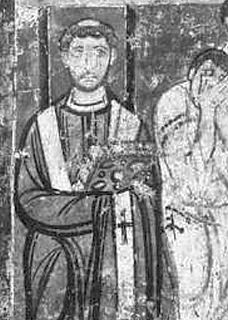
Pope Leo IV was the bishop of Rome and ruler of the Papal States from 10 April 847 to his death. He is remembered for repairing Roman churches that had been damaged during the Arab raid against Rome, and for building the Leonine Wall around Vatican Hill to protect the city. Pope Leo organized a league of Italian cities who fought and won the sea Battle of Ostia against the Saracens.
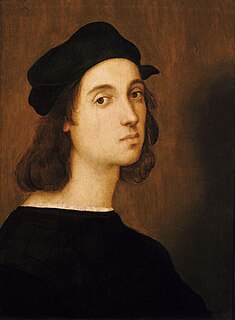
Raffaello Sanzio da Urbino, better known as Raphael, was an Italian painter and architect of the High Renaissance. His work is admired for its clarity of form, ease of composition, and visual achievement of the Neoplatonic ideal of human grandeur. Together with Leonardo da Vinci and Michelangelo, he forms the traditional trinity of great masters of that period.

The Apostolic Palace is the official residence of the Pope, the head of the Catholic Church, located in Vatican City. It is also known as the Papal Palace, the Palace of the Vatican and the Vatican Palace. The Vatican itself refers to the building as the Palace of Sixtus V, in honor of Pope Sixtus V, who built most of the present form of the palace.

Giulio Romano, is the acquired name of Giulio Pippi, who was an Italian painter and architect. He was a pupil of Raphael, and his stylistic deviations from High Renaissance classicism help define the sixteenth-century style known as Mannerism. Giulio's drawings have long been treasured by collectors; contemporary prints of them engraved by Marcantonio Raimondi were a significant contribution to the spread of sixteenth-century Italian style throughout Europe.
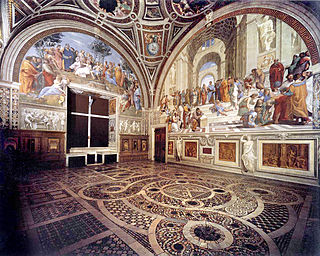
The four Raphael Rooms form a suite of reception rooms in the Apostolic Palace, now part of the Vatican Museums, in Vatican City. They are famous for their frescoes, painted by Raphael and his workshop. Together with Michelangelo's Sistine Chapel ceiling frescoes, they are the grand fresco sequences that mark the High Renaissance in Rome.

Borgo is the 14th rione of Rome, Italy. It is identified by the initials R. XIV and is included within Municipio I.

The Transfiguration is the last painting by the Italian High Renaissance master Raphael. Cardinal Giulio de Medici – who later became Pope Clement VII – commissioned the work, conceived as an altarpiece for Narbonne Cathedral in France; Raphael worked on it in the years preceding his death in 1520. The painting exemplifies Raphael's development as an artist and the culmination of his career. Unusually for a depiction of the Transfiguration of Jesus in Christian art, the subject is combined with the next episode from the Gospels in the lower part of the painting. The work is now in the Pinacoteca Vaticana in the Vatican City.
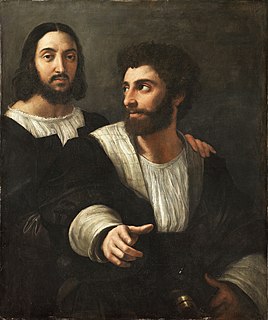
The Self-Portrait with a Friend is a painting by Italian High Renaissance painter Raphael. It dates to 1518–1520, and is in the Louvre Museum of Paris, France. Whether the figure on the left is actually a self-portrait by Raphael is uncertain, although it was already identified as such in a 16th-century print.

Aeneas, Anchises, and Ascanius is a sculpture by the Italian artist Gian Lorenzo Bernini created c. 1618-19. Housed in the Galleria Borghese in Rome, the sculpture depicts a scene from the Aeneid, where the hero Aeneas leads his family from burning Troy.
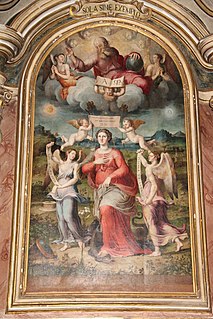
Raffaellino del Colle (1490–1566) was an Italian Mannerist painter active mostly in Umbria. He was born in the frazione of Colle in Borgo Sansepolcro, province of Arezzo, Tuscany, Italy.

The Madonna della Seggiola or The Madonna della Sedia is an oil on panel Madonna painting by the High Italian Renaissance artist Raphael, executed c. 1513–1514, and housed at the Palazzo Pitti Collection in Florence, Italy. Although there is documentation on its arrival to its current location, Palazzo Pitti, it is still unknown who commissioned the painting; however, it has been in the Medici family since the 16th century.

The Disputation of the Sacrament, or Disputa, is a painting by the Italian Renaissance artist Raphael. It was painted between 1509 and 1510 as the first part of Raphael's commission to decorate with frescoes the rooms that are now known as the Stanze di Raffaello, in the Apostolic Palace in the Vatican. At the time, this room was known as the Stanza della Segnatura, and was the private papal library where the supreme papal tribunal met.

The Coronation of Charlemagne is a painting by the workshop of the Italian Renaissance artist Raphael. Though it is believed that Raphael did make the designs for the composition, the fresco was probably painted by Gianfrancesco Penni. The painting was part of Raphael's commission to decorate the rooms that are now known as the Stanze di Raffaello, in the Apostolic Palace in the Vatican. It is located in the room that was named after The Fire in the Borgo, the Stanza dell'incendio del Borgo.

The Battle of Ostia is a painting by the workshop of the Italian Renaissance artist Raphael. The painting was part of Raphael's commission to decorate the rooms that are now known as the Stanze di Raffaello, in the Apostolic Palace in the Vatican. It is located in the room that was named after The Fire in the Borgo, the Stanza dell'incendio del Borgo and was inspired by the naval battle fought in 849 between the Arab and a Christian League of Papal, Neapolitan and Gaetan ships. In the painting Pope Leo IV, with the features of Pope Leo X, is giving thanks after the Arab ships were destroyed by a storm.

The Oath of Leo III is a painting by the workshop of the Italian renaissance artist Raphael. The painting was part of Raphael's commission to decorate the rooms that are now known as the Stanze di Raffaello, in the Apostolic Palace in the Vatican. It is located in the room that was named after The Fire in the Borgo, the Stanza dell'incendio del Borgo. In the fresco, Pope Leo III is seen during the trial on December 23 AD 800 during which he was brought face to face with the nephews of his predecessor Pope Hadrian I, who had accused him of misconduct. The assembled bishops declared that they could not judge the pope, after which Leo took an oath of purgation of his own free will.
Events from the year 1514 in art.

The Corps of Firefighters of the Vatican City State is the fire brigade of the Vatican City State. It was founded in its present form by Pope Pius XII in 1941, although its origins are much older.

Palazzo dei Convertendi is a reconstructed Renaissance palace in Rome. It originally faced the Piazza Scossacavalli, but was demolished and rebuilt along the north side of Via della Conciliazione, the wide avenue constructed between 1936 and 1950, which links St Peter's Basilica and the Vatican City to the centre of Rome. The palace is famous as the last home of the painter Raphael, who died there in 1520.

The Palazzo Rusticucci-Accoramboni is a reconstructed late Renaissance palace in Rome. Erected by the will of Cardinal Girolamo Rusticucci, it was designed by Domenico Fontana and Carlo Maderno joining together several buildings already existing. Due to that, the building was not considered a good example of architecture. Originally lying along the north side of the Borgo Nuovo street, after 1667 the building faced the north side of the large new square located west of the new Saint Peter's Square, designed in those years by Gian Lorenzo Bernini. The square, named Piazza Rusticucci after the palace, was demolished in 1937–40 because of the erection of the new Via della Conciliazione. In 1940 the palace was dismantled and rebuilt with a different footprint along the north side of the new avenue, constructed between 1936 and 1950, which links St Peter's Basilica and the Vatican City to the center of Rome.

Borgo Nuovo, originally known as via Alessandrina, also named via Recta or via Pontificum, was a road in the city of Rome, Italy, important for historical and architectural reasons. Built by Pope Alexander VI Borgia for the holy year of 1500, the road became one of the main centers of the high Renaissance in Rome. Borgo Nuovo was demolished together with the surrounding quarter in 1936–37 due to the construction of Via della Conciliazione.



















